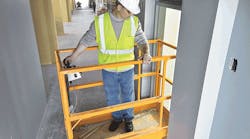The fatal injury rate for mobile elevating work platforms (MEWPs), or aerial work platforms (AWPs), has remained constant, even though the total MEWP rental fleet and the number of rental days worldwide have increased. International Powered Access Federation’s release of the 2015 MEWP-related accident data and its preliminary fatal injury rate calculations find that for 2015, the number of days a rented machine was operated per year was 192.2 million and the number of reported MEWP fatalities was 68, to give a fatal injury rate of 0.035. Of the 68 reported MEWP fatalities for 2015, the main causes were overturn, falls from height, electrocution and entrapment.
In 2014, the number of days a rented machine was operated per year was 182.4 million and the number of reported MEWP fatalities was 64, to give a fatal injury rate of 0.035. In 2013, the number of days a rented machine was operated per year was 168.4 million and the number of reported MEWP fatalities was 68, to give a fatal injury rate of 0.040.
The accident data from 2013 to 2015 show that the main causes of MEWP-related fatalities were: fall from height (31 percent), overturn (27 percent), electrocution (15 percent) and entrapment (15 percent).
The MEWP fatal injury rate as calculated by IPAF takes into account the following factors:
- Estimated rental fleet size, based on the IPAF Powered Access Rental Market Reports.
- Estimated average utilization rates per country and worldwide (utilization rate is defined as the share of the fleet out on rent at any time over a year).
- Average days worked per year (5 days a week for 50 weeks a year).
- The number of fatalities involving MEWPs in a given year, based on the IPAF accident-reporting project.
IPAF’s accident reporting project, launched in 2012, is gradually creating a comprehensive record of known accidents. The accident data gathered enables IPAF to improve the content of training programs, to develop technical guidance, to target specific high-risk professions or activities and to provide research findings used to influence standards.
All manufacturers, rental companies, contractors and users are encouraged to report all known accidents (not just fatal and serious accidents) involving MEWPs and MCWPs (mast climbing work platforms) at www.ipaf.org/accident.


